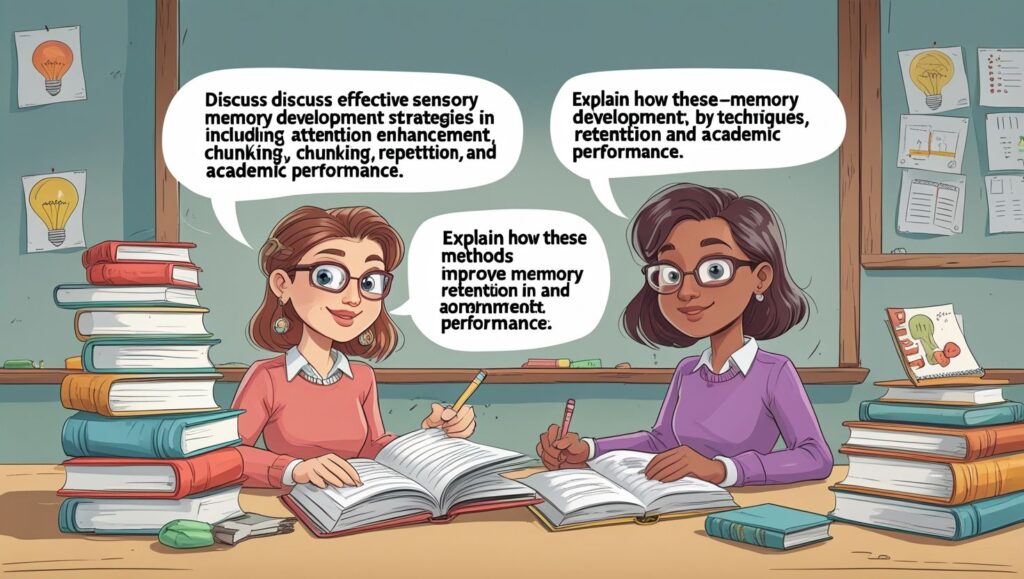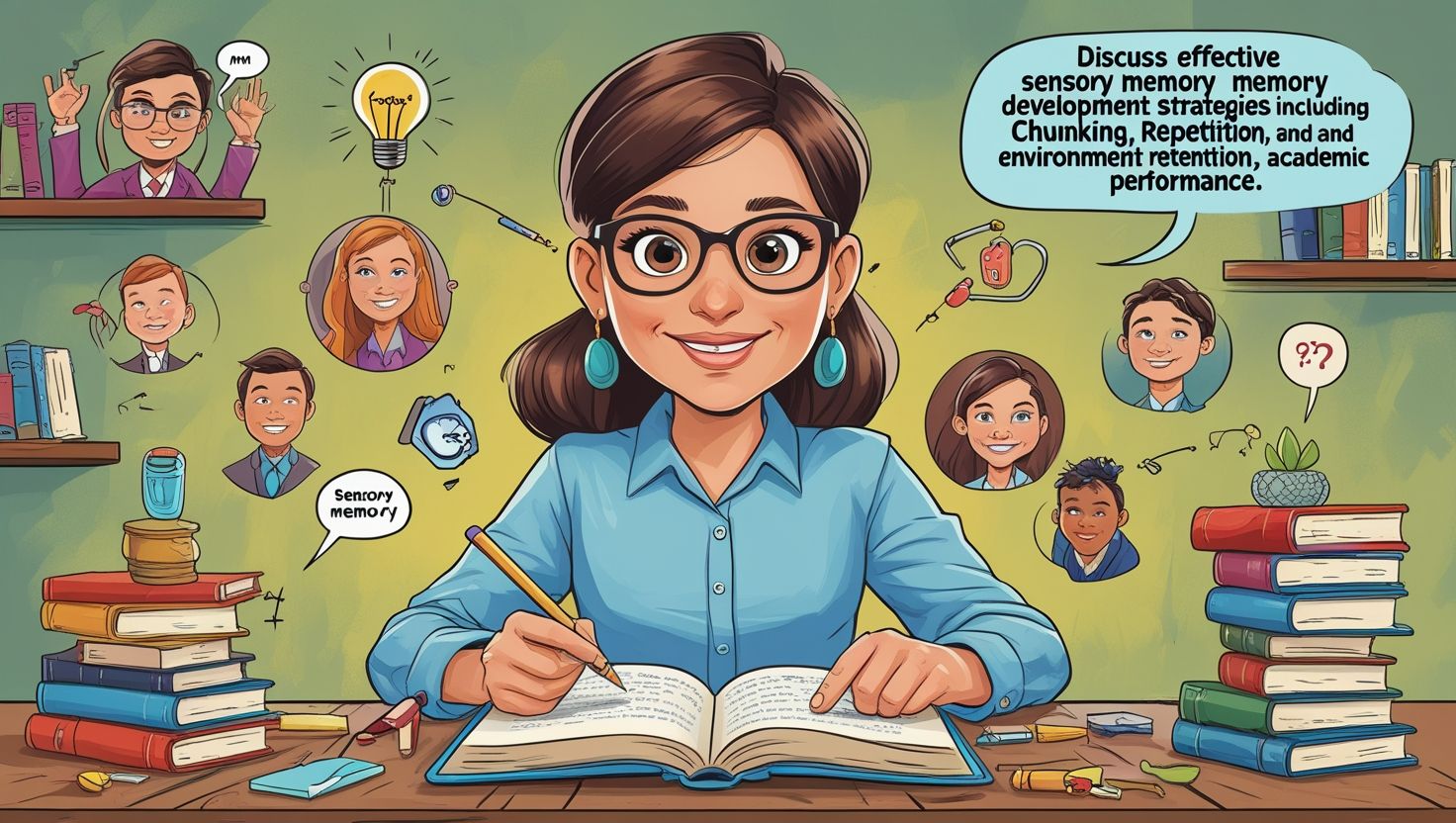Introduction
Sensory Memory Development Strategies in Learning, Sensory memory is the first stage of memory processing, where sensory information from the environment is briefly retained in its raw form. It acts as a buffer for stimuli received through the five senses—sight (iconic memory), sound (echoic memory), touch (haptic memory), taste, and smell. This type of memory lasts only a fraction of a second but plays a crucial role in determining which information is transferred to short-term and long-term memory for further processing.
In learning, sensory memory helps filter and prioritize relevant information, making it essential for effective knowledge acquisition. Educators and learners can optimize sensory memory through targeted strategies that enhance attention, perception, and retention. This article explores sensory memory development strategies in learning, focusing on practical techniques for improving memory retention and academic performance.
Understanding Sensory Memory
Before delving into development strategies, it is essential to understand the characteristics of sensory memory:
- Brief Duration – Sensory memory holds information for a very short time (less than a second for iconic memory, up to 3-4 seconds for echoic memory).
- High Capacity – It can store a large amount of sensory input but only retains it momentarily.
- Automatic Processing – Sensory memory operates without conscious effort, continuously absorbing environmental stimuli.
- Selective Transfer – Only relevant or attended information moves to short-term memory.
Given these features, enhancing sensory memory involves improving the detection, selection, and transfer of meaningful information.
Sensory Memory Development Strategies in Learning
1. Multi-Sensory Learning Techniques
Engaging multiple senses simultaneously strengthens memory encoding by creating richer neural connections. Some effective multi-sensory strategies include:
- Visual Aids – Using diagrams, charts, videos, and color-coding to reinforce learning.
- Auditory Reinforcement – Incorporating lectures, discussions, rhymes, and mnemonic devices.
- Kinesthetic/Tactile Learning – Hands-on activities, experiments, and movement-based learning (e.g., writing notes, using manipulatives).
- Olfactory & Gustatory Cues – Associating specific smells or tastes with learning contexts (e.g., chewing gum while studying and during exams).
Example: A teacher explaining a scientific concept with a visual diagram, verbal explanation, and a hands-on experiment helps students retain information better than a lecture alone.
2. Chunking and Pattern Recognition
Since sensory memory has a brief duration, presenting information in organized chunks helps the brain process and retain it more efficiently.
- Grouping Related Information – Breaking down complex data into smaller, related units (e.g., phone numbers as 3-3-4 digits).
- Using Rhymes and Patterns – Mnemonics, acronyms, and rhythmic patterns aid in quicker recall.
Example: Medical students use acronyms like “ROYGBIV” for the colors of the rainbow or “My Very Educated Mother Just Served Us Noodles” for planetary order.

3. Attention and Focus Enhancement
Since only attended sensory information moves to short-term memory, improving focus is critical. Strategies include:
- Eliminating Distractions – Creating a quiet, clutter-free study environment.
- Active Listening & Observation – Encouraging learners to summarize or repeat key points.
- Mindfulness & Meditation – Practices that improve concentration and sensory awareness.
Example: A student practicing mindfulness before studying may notice improved retention of lecture material.
4. Repetition and Spaced Learning
Repeating sensory input strengthens neural pathways, increasing the likelihood of transfer to long-term memory.
- Spaced Repetition – Reviewing material at increasing intervals (e.g., 1 day, 3 days, 1 week later).
- Frequent Exposure – Revisiting key concepts through quizzes, flashcards, or discussions.
Example: Language learners using apps like Anki benefit from spaced repetition algorithms.
5. Environmental Enrichment
A stimulating learning environment enhances sensory memory by providing varied and meaningful stimuli.
- Interactive Classrooms – Using multimedia, real-world objects, and interactive displays.
- Nature & Sensory Walks – Outdoor learning engages multiple senses, improving memory retention.
Example: A history lesson in a museum allows students to see, touch, and hear historical artifacts, reinforcing learning.
6. Associative Learning
Linking new information to existing knowledge helps anchor sensory input in memory.
- Analogies & Metaphors – Comparing new concepts to familiar ones.
- Emotional Connections – Emotionally charged experiences are remembered better.
Example: A teacher explaining electrical circuits using a water flow analogy makes the concept more relatable.
7. Physical Movement & Gestures
Incorporating movement enhances sensory memory by engaging the motor cortex.
- Hand Gestures While Teaching – Teachers using gestures help students visualize concepts.
- Role-Playing & Simulations – Acting out scenarios reinforces memory.
Example: Acting out a historical event helps students remember details better than passive reading.
8. Sleep & Memory Consolidation
Sleep plays a vital role in transferring sensory and short-term memories into long-term storage.
- Adequate Rest Before Learning – A well-rested brain processes sensory input more efficiently.
- Naps After Learning – Short naps help consolidate newly acquired information.
Example: Students who sleep after studying perform better on memory tests than those who stay awake.
Conclusion
Sensory memory is a foundational component of the learning process, acting as the gateway for all incoming information. By employing strategies such as multi-sensory learning, attention enhancement, chunking, repetition, and environmental enrichment, educators and learners can optimize sensory memory for better retention and academic success.
Developing sensory memory not only improves immediate recall but also strengthens overall cognitive abilities, leading to more effective and lasting learning outcomes. Implementing these strategies in classrooms and self-study routines can transform the way students absorb and retain knowledge, paving the way for lifelong learning success.
Final Thoughts
As research in cognitive psychology advances, new techniques for enhancing sensory memory will continue to emerge. Educators should stay informed about evidence-based strategies to support learners in harnessing the full potential of their sensory memory systems. By doing so, they can create more engaging, effective, and memorable learning experiences.

9 thoughts on “Sensory Memory Development Strategies in Learning”